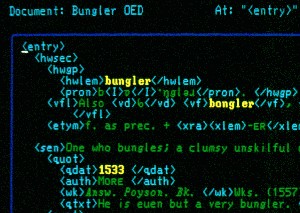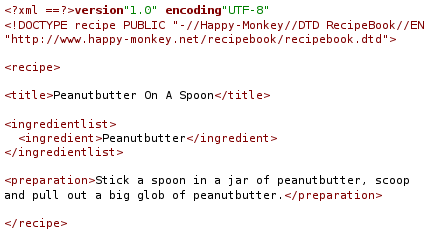A markup language is an artificial language that uses a set of annotations to text that give information about the structure of the text or how it must be displayed. The term ‘markup’ comes from the traditional publishing practice of ‘marking up’ a manuscript, what involves adding symbolic printer’s instructions in the margins. For centuries, this task was done by skilled typographers known as ‘markup men’ who took down these symbols in the texts to indicate what typeface, style, and size should be applied to each part. Markup languages have been applied by editors, proofreaders, and graphic designers, and recently have been used in computer typestting and word-processing systems too.

A specialized markup language based on SGML is used in the digital version of the Oxford English Dictionary.
The first idea about a markup language in this computer science world that we are studying appeared in 1967 thanks to William W. Tunnicliffe, who led the development of a standard called GenCode for the publishing industry and later was a chair of the International Organization for Standardization committee. However, the IBM researcher Charles Goldfarb is considered the ‘father’ of markup languages because of his work at the SGML committee, the first widely used descriptive markup language.
SGML (Standard Generalized Markup Language) specified a syntax to include the markup in documents, as well as another to describe what tags were allowed. Authors were permited to create and use any markup they wanted, selecting tags that made sense to them. In other words, SGML was, in fact, a meta-language. However, SGML had a weak point: it was difficult to learn.
In 1991, Tim Berners-Lee, using the SGML syntax created HTML (HyperText Markup Language). HTML‘s use of descriptive markup was a key factor in the success of the Web, because of the enormous flexibility that it enabled, making of this markup language the most extended world wide.

Example of RecipeBook, a simple markup language based on XML for creating recipes.
Another important markup language is the XML (eXtensible Markup Language), developed by the World Wide Web Consortium (W3C) to simplify SGML increasing markup size and reducing readability and editability, in a committee chaired by Jon Bosak.
After the appearance of the XML, the World Wide Web Consortium (W3C) created the XHTML (eXtensive HyperText Markup Language) to integrate in one system the benefits of XML and HTML at the same time.
References:
- Markup language. (2008, December 22). In Wikipedia, The Free Encyclopedia. Retrieved 17:53, December 27, 2008, from
http://en.wikipedia.org/w/index.php?title=Markup_language&oldid=259594044 - HTML. (2008, December 17). In Wikipedia, The Free Encyclopedia. Retrieved 20:51, December 18, 2008, from
http://en.wikipedia.org/w/index.php?title=HTML&oldid=258572477 - XML. (2008, December 17). In Wikipedia, The Free Encyclopedia. Retrieved 20:51, December 18, 2008, from
http://en.wikipedia.org/w/index.php?title=XML&oldid=258500078 - Carolina García Cataño y David Arroyo Menéndez. (2002). Biblioteca Digital y Web Semántica. BiblioWeb de SinDominio. Retrieved 21:12, 2008, December 18, from
http://biblioweb.sindominio.net/telematica/bibdigwebsem/bibdigwebsem.html - Standard Generalized Markup Language. (2008, September 9). In Wikipedia, The Free Encyclopedia. Retrieved 17:55, December 27, 2008, from
http://en.wikipedia.org/w/index.php?title=Standard_Generalized_Markup_Language&oldid=237343244 - Christian Van Der Henst S. (2003, November 11) ¿Cómo se diferencia el XML del HTML? In Maestros del Web. Retrieved 21:03, 2008, December 18, from
http://www.maestrosdelweb.com/editorial/xmlvshtml - XHTML. (2008, December 21). In Wikipedia, The Free Encyclopedia. Retrieved 17:56, December 27, 2008, from
http://en.wikipedia.org/w/index.php?title=XHTML&oldid=259405743 - María Jesús Lamarca Lapuente. (2006). Hipertexto: El nuevo concepto de documento en la cultura de la imagen. Tesis doctoral. UCM. Retrieved 21:02, 2008, December 18, from
http://www.hipertexto.info/documentos/lenguajes_h.htm - Miguel Ángel Álvarez. (2001, June 21) Diferencias entre HTML y XML. In Desarrollo Web. Retrieved 21:08, 2008, December 18, from
http://www.desarrolloweb.com/articulos/459.php
0 Responses to “Markup languages, from printer to the Web”